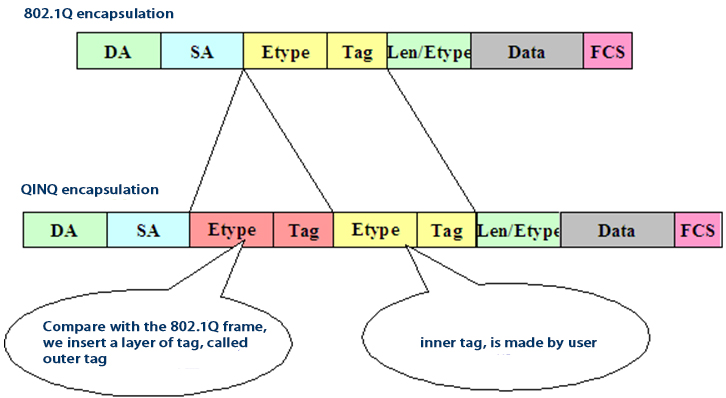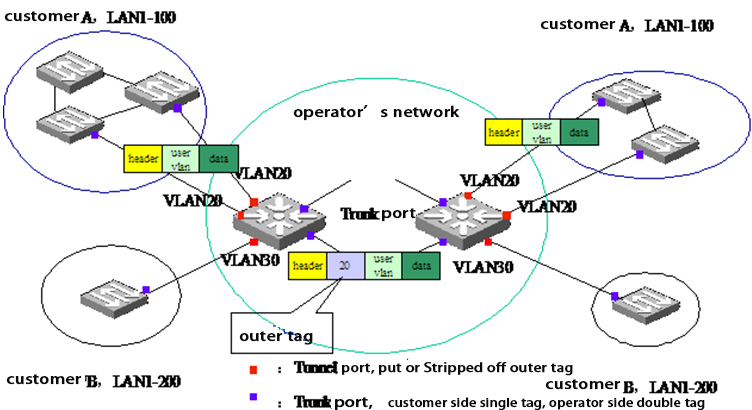QINQ technology knowledge
QinQ technology (also called Stacked VLAN or Double VLAN) refers to encapsulating the user's private VLAN tag in the public network VLAN tag so that the packet carries the two-layer VLAN tag go to the backbone network of the operator. Out Layer VLAN tag propagation in the public network, private VLAN tag is blocked, so that not only the data stream is distinguished, and because the private VLAN tag is transparent transmission, different user VLAN tags can be reused, just only the outer VLAN tag in the public network is unique, in fact, also expanded the number of available VLAN tags.
QinQ standard is IEEE802.1ad (IEEE802.1ad full name is: Virtual Bridged Local Area Networks Amendment 4: Provider Bridges) The standard is form a formal standard in May 2006 to, so the QinQ which current common vendors achieve is different from this standard, but the implementation of the vendors are similar.
1. The generation of QinQ
1.1 with the three-layers switches continue to be mature and more applications, many enterprise networks and small metropolitan area network users tend to use three layers switches to build the backbone network, because of the following three reasons, these users are generally reluctant to use the VPN based on MPLS Or IP protocol:
Configuration and maintenance work is relatively complex;
Many of the three-layers switches do not support MPLS functions, if users build MPLS-based VPN, then it must eliminate these devices, a waste of resources;
Boards that support MPLS functionality are generally expensive and can not be tolerated by small users.
But QinQ can provide an inexpensive and concise two Layer VPN solution, does not require signaling protocol support. It can be realized via static configuration, and only needs the network edge devices supporting QinQ, the internal only need the device which support 802.1Q, so more and more small users tend to use this feature to build their own VPN network.
1.2. Operators need to do identification for the customers when provide Internet access services through Ethernet, to realize the exact management, and with the new business development (such as Triple-Play, Wholesale, VPN), operators also need to segment the business, To distinguish between different channels, QoS policies. The original Based on 802.1Q only has 4096 vlan identification can not meet this need, QinQ just can expand such identification, but also can use different VLAN to distinguish between the operator's services and different customers. The following advantages are provided when using QinQ to provide access
can solve the increasingly scarce public network VLAN ID resource problem;
• Users can plan their own private VLAN ID, which does not cause conflicts with public network VLAN IDs.
• provide a simpler 2 Layer VPN solution;
• make the user network has a high degree of independence, when the service provider upgrade the network, the user network no need to change the original configuration;
• Can differentiate different service based on different types of VLAN IDs
• QinQ technology can be nested in multiple layers. There is no limit. It is limited by the length of Ethernet packets and has good scalability.
2. QinQ packet encapsulation
QinQ encapsulation packets is adding a TAG encapsulation based on the original 802.1Q packet, which is used to extend the VLAN range. As shown in Figure 1,

diagram 1 QinQ packet encapsulation
3. QinQ packet forwarding process is in the process of realizing simple layer 2 VPN through QinQ forward message is as follows:

Diagram 2 QinQ forwarding process of packet message
In figure 2, the operation network use VLAN20 to identify customer A, VLAN30 identify customer B, when customers A’S message reach to the edge of operator switches, the edge switches are give customers A’s message on for outer tag (VLAN20), and then forwarded in VLAN20, won't be forwarded to the VLAN30, after the message leave away from operator’s network, then stripping the outer label, forwarded to the users A’s network, so as to realize simple 2 layer VPN function.
TAK communication company’s PDH multiplexer Ethernet also support QINQ function to meet user’s need. If interesting it, please feel free to contact us.

QINQ PDH multiplexer


 Address: NO.220, Qiutao Road, HangzhouCity,Zhejiang Province, China
Address: NO.220, Qiutao Road, HangzhouCity,Zhejiang Province, China  Tel: 0086-571-28184719
Tel: 0086-571-28184719 Fax: 0086-571-28184719
Fax: 0086-571-28184719

